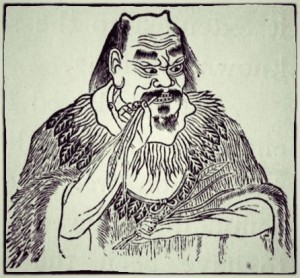Etiology
“In general there are many reasons that patients develop acute and/or chronic sinusitis including allergies, head colds deviated septum, exposure to chemicals and pollutants (including cocaine), etc.” (Vol. 2, Pg. 87)
“For the discussion related to the respiratory system, it is sufficient to understand that the basis of health depends on the intact structure of the Three Warmers and that the interrelationship between the Kidneys and Lungs depend on the water<>steam<>condensation cycle between the Three Warmers. It is also important to understand that the Lower Warmer must be kept warm (lower abdomen must be warm) at any time and that the Upper Warmer (Lungs and Heart) should always be kept cooler for the condensation cycle to occur. An imbalance at the area of T7 (one of the “Seven Segment” sections) might cause Zong Qi to leak and the Upper Warmer to become too hot as the Lower Warmer (Kidney) becomes deficient.” (Vol. 2, Pg. 60)
“Master Hakuin (in his book Yasenkanna – Night Boat Calming Story) describes his symptoms as Heat in the head, insomnia, speech disorder, tearing eyes, eye pain, and tinnitus. According to his terminology, Heat Fire rebels upwards, confusing the Heart Shen and drying the Lung Metal. When his armpit began to sweat and he had no appetite he also had cold feet. This is a Zong Qi leaking syndrome.” (Vol. 2, Pg. 61)
Diagnosis
“The diagnostic features to be considered are at the area of St2 (maxillary sinuses) and at the area of Bl2 and Yuyao (frontal sinuses) as well as around the umbilicus (general allergy and sinus reflection).” (Vol2, Pg 87)
Treatment
- Treat with 15 thread moxa. No needle required.
- Find the location of GB40 at the puffy area at the posterior-medial edge of the lateral malleolus. Press upwards against the bone and find the exact location to reduce pressure pain at the sinuses (in particular the maxillary sinuses).
- Gallbladder channel: GB43 and GB44
- Urinary Bladder channel: UB66 and UB67
- Stomach channel: ST43 and ST44
- Needle with a #1 (0.16mm) needle.
- Add 5-7 thread moxa if feet are cold.
- Locate the point directly on the midline or slightly to the side, depending on pressure pain. There may be a soft, puffy area.
- Treat with moxa. Use plenty of shiunko and small enough cones to prevent blistering.
- This is most common at the end of a common head cold.
- Front treatment: KD6, KD27, LU5, SP9, SP10, DU23.
- Back treatment: DU12, UB13
- If other treatments have not relieved the pressure pain at ST2, apply gold-plated magnetic diode rings. These should be placed on the cheeks at the area of UB2 and Yuyao. (See Vol. 1 pg. 295)
- For very stubborn cases: Connect diode rings to triple bypass cord and stimulate with pachi-pachi. (See Vol. 1 pg. 457-458)
Master Kawai’s method for very stubborn sinusitis:
- Insert #5 (0.25) needles (40mm or 50mm) at UB2, Master Kawai’s nose point or Bitong, and Taiyang.
- Attach a triple bypass:
- At the more painful UB2 area: black clip
- At Taiyang on the same side as UB2: green clip
- Opposite side Taiyang: red clip
- Apply kyutoshin moxa on all needles, but do not light yet. Use clips and tape as needed to stabilize needles.
- Connect the black clip of the triply bypass to the back of a pachi-pachi and retain until kyutoshin is complete.
- Ignite the kyutoshin. Cover the patient’s eyes with damp gauze to protect from the moxa smoke.
- Remove kyutoshin and triple bypass
- Stimulate UB2 once more.
Navel:
- REN8 is an image for the nose. Needle points around REN8 for sinusitis and allergies.

